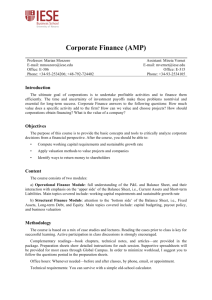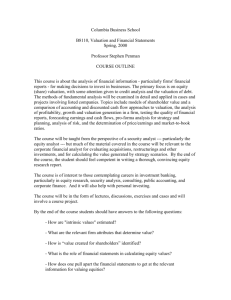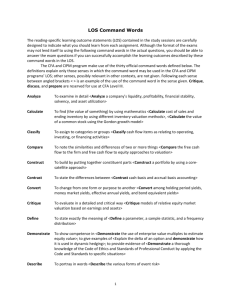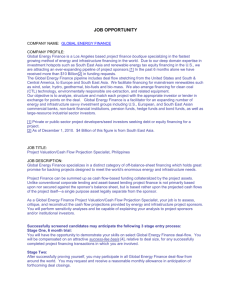CORPORATE FINANCE
advertisement
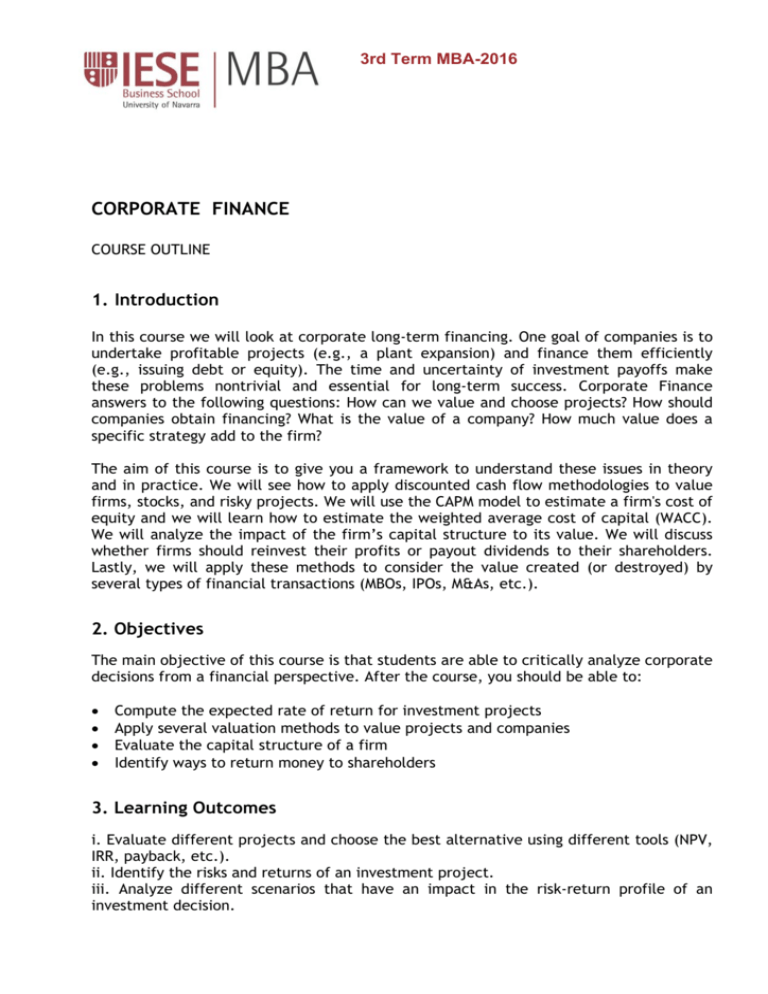
3rd Term MBA-2016 CORPORATE FINANCE COURSE OUTLINE 1. Introduction In this course we will look at corporate long-term financing. One goal of companies is to undertake profitable projects (e.g., a plant expansion) and finance them efficiently (e.g., issuing debt or equity). The time and uncertainty of investment payoffs make these problems nontrivial and essential for long-term success. Corporate Finance answers to the following questions: How can we value and choose projects? How should companies obtain financing? What is the value of a company? How much value does a specific strategy add to the firm? The aim of this course is to give you a framework to understand these issues in theory and in practice. We will see how to apply discounted cash flow methodologies to value firms, stocks, and risky projects. We will use the CAPM model to estimate a firm's cost of equity and we will learn how to estimate the weighted average cost of capital (WACC). We will analyze the impact of the firm’s capital structure to its value. We will discuss whether firms should reinvest their profits or payout dividends to their shareholders. Lastly, we will apply these methods to consider the value created (or destroyed) by several types of financial transactions (MBOs, IPOs, M&As, etc.). 2. Objectives The main objective of this course is that students are able to critically analyze corporate decisions from a financial perspective. After the course, you should be able to: Compute the expected rate of return for investment projects Apply several valuation methods to value projects and companies Evaluate the capital structure of a firm Identify ways to return money to shareholders 3. Learning Outcomes i. Evaluate different projects and choose the best alternative using different tools (NPV, IRR, payback, etc.). ii. Identify the risks and returns of an investment project. iii. Analyze different scenarios that have an impact in the risk-return profile of an investment decision. iv. Perform stock valuation by means of relative valuation/multiples. v. Assess the acquisition of a non-listed company by considering different factors: strategic fit, stakeholders’ interests or different values of the firm depending on the point of view of each party. vi. Distinguish different ways of financing a company and determine the effects of leverage. vii. Evaluate the specific characteristics of a Private Equity acquisition. viii. Calculate and interpret the cost of equity and debt financing. ix. Determine the Weighted Average Cost of Capital and its consequences in the value of a company. x. Assess an M&A deal considering important issues: Discounted Cash Flow and Multiples valuations, cost of capital, terminal value, etc. xi. Identify different dividend policies and specify the outcome of each alternative. xii. Perform IPO analysis by knowing the mechanics and how the price is chosen. xiii. Determine the best way to carry out a Management Buy Out. 4. Competences General Competences: Decision Making Critical Thinking Judgment Conciseness Specific Competences: Understand and apply appropriate quantitative and qualitative analysis and tools to the investment and financing process in the presence of risk and uncertainty. Emit consistent and unbiased judgments taking adequately into account the characteristics and circumstances of the decision. 5. Content The course is divided in four modules: Project Evaluation (4 sessions): This module provides the basic tools to make decisions on projects. What is the value of a project? Should the firm undertake it? Valuation Methods (5 sessions): This module develops different methodologies used to value a firm and discusses different ways to create corporate value. Financing and cost of capital (3 sessions): In this module, we will analyze the cost of equity and the cost of debt in financial markets—leverage of firms, risk, and the average cost of capital of the firm. Advanced Topics in Corporate Valuation (6 sessions): The last module of the course applies all the corporate finance concepts to mergers and acquisitions (M&A), leveraged buyouts (LBOs), dividend policy, initial capital/private equity (VC/PE) financing. public offerings (IPOs), and venture 6. Methodology Method: The course is case-based (i.e., 15 sessions are based on cases, 3 sessions are lectures, and 2 review sessions). Cases, technical notes, and readings will be assigned for each session. Cases require heavy preparation. You are expected to participate constructively in class discussions. Textbooks and materials Textbook: Finance for Managers, by E. Martinez Abascal (EMA). Optional textbook (advanced): Corporate Finance, by S. Ross, R. Westerfield and J. Jaffe, 7th edition (RWJ). Preparation Sheets show detailed instructions for each session, with reading requirements from EMA excerpts, technical notes, and articles (some of them optional and available on blackboard). Supportive spreadsheets will be provided for most of the cases. Valuation project: There will be a company valuation report to be submitted near the end of the course. More details will be announced later. Office hours: By appointment and via email. Tech requirements: Cell phones and laptops shut off and down—tablets and readers allowed for class materials. 7. Evaluation Your final course grade will depend on three components: Professionalism (20%), i.e., constructive, well-bred, and timely class and off-class interaction Midterm (30%) Company Valuation Report (20%) Final Exam (30%) Learning outcomes will be measured in the following way: Midterm and final exam with decision making problems that require evaluating projects using NPV, IRR, risk-return characteristics and scenario analysis (outcomes i-iii), value companies using comparables (outcome iv), discuss the acquisition of non-listed companies (outcome v), calculate the cost of financing a company and measure the impact of choosing different alternatives (outcome vi, viii and ix), Private Equity investment analysis (outcome vii), determine the value of a company in M&A transactions (outcome x), evaluate different dividend policies (outcome xi), explain the mechanics on an IPO (outcome xii) and justify the best way to do a Management Buy Out in a given context (outcome xiii). Hand in of a Field project in which the students must implement all the financial techniques acquired during the course to value a firm (all outcomes). 8. Course Outline & Bibliography Session 1 2 3 4 5 6 7 8 9 Title of Session & Material Project Evaluation (Capital Budgeting) Project Evaluation (Lecture) EMA, Chapter 6. Introduction to Structural Finance Project Evaluation. Methodology Case: IESE F-760-E, AC Hotels. Investment in New Hotels EMA, Chapter 7. Investment Project Analysis and Decision Project Evaluation. Risk versus Return Same material as previous session Project Evaluation. Criteria to Decide Case: IESE F-757-E, The Marti Pig Farm Investment Decision Valuation Methods Valuation with Multiples Case: IESE F-845-E, Volkswagen AG: Valuation in 2009 Article: The right role for multiples in valuation, Marc Goedhart, Timothy Koller and David Wessels, Mckinsey Quarterly, Spring 2005 Valuation with Equity Cash Flow Case: IESE F-818-E, Warehouse Industries EMA, Chapter 10. Financing Decisions: Debt vs. Equity Valuation with Equity Cash Flow Same material as previous session Decision Debt versus Equity Case: IESE F-823-E, Logisware EMA, Chapter 9. Financing Decisions: Debt vs. Equity Private Equity Case: IESE F-792-E: Cofinec: A Private Equity Acquisition in Central Europe Review and Midterm Exam 10 — 11 12 Review Session Technical Note: IESE FN-0624-E: Corporate Finance Questions. Topic: Project Evaluation Technical Note: IESE FN-0625-E: Corporate Finance Questions. Topic: Valuation Methods Midterm Exam Financing and cost of capital Cost of Equity and Cost of Debt (Lecture) RWJ: Chapter 10, Sections 10.1–10.4, and 10.9 Exercise on cost of capital and betas (on Global Campus) Unlevering and Relevering Returns to Estimate the WACC Case: HBS 4129: Midland Energy Resources, Inc.: Cost of Capital Teaching note: Formulas needed for WACC calculations by P. Saffi and C. Vergara 13 14 15 16 17 18 19 20 — WACC per Division Same material as previous session Advanced Topics in Corporate Valuation Valuation of an M&A using WACC Case: HBS 9-291-033, Interco RWJ: Chapter 29 Valuation of an M&A using Multiples Same material as previous session Dividend Policy Case: HBS 9-204-066, Dividend Policy at Linear Technology Analysis of Initial Public Offerings (IPOs) Case: HBS 9-196-138: Boston Beer, Inc. Valuation of a Leveraged Buyout (LBO) Case: HBS 9-291-008, John M. Case Company Field Project Review and Final Exam Review Session Technical Note: IESE FN-0626-E: Corporate Finance Questions. Topic: Financing and Cost of Capital Final Exam

